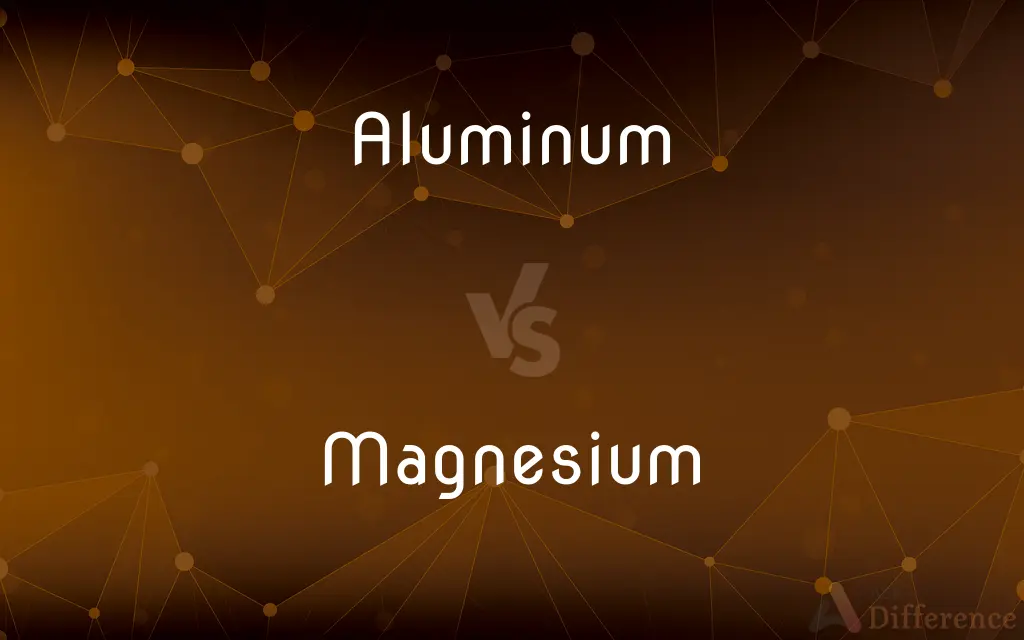Aluminum vs. Magnesium — What's the Difference?
Edited by Tayyaba Rehman — By Urooj Arif — Updated on April 23, 2024
Aluminum is lightweight and corrosion-resistant, commonly used in transport and packaging, while magnesium is even lighter and often used in aerospace and electronics.

Difference Between Aluminum and Magnesium
Table of Contents
ADVERTISEMENT
Key Differences
Aluminum, a silvery-white metal, is known for its durability and resistance to corrosion, making it ideal for applications like beverage cans and construction materials. Magnesium, on the other hand, is even lighter than aluminum, offering benefits for high-performance applications like racing components and aerospace engineering.
Aluminum has a density of about 2.70 g/cm³, which contributes to its widespread use in automotive and transport industries for reducing weight without sacrificing strength. Magnesium, whereas, has a lower density of about 1.74 g/cm³, providing even greater weight savings, which is crucial in applications like portable electronics and aircraft manufacturing.
When it comes to melting points, aluminum has a higher melting point of about 660 degrees Celsius, which allows for its use in high-temperature environments and applications. Magnesium, on the other hand, has a melting point of about 650 degrees Celsius, which slightly limits its use in higher temperature scenarios.
Aluminum is typically less expensive and more abundant in the earth's crust, making it more accessible and commonly used across various industries. Magnesium, whereas, while also abundant, often costs more to extract and refine, which can affect its usage in mass-production scenarios.
Aluminum alloys are generally easier to work with and can be found in a wide range of mechanical applications due to their malleability and ductility. Magnesium alloys, on the other hand, often require more specialized handling and protection from corrosion through coatings or treatments.
ADVERTISEMENT
Comparison Chart
Density
2.70 g/cm³
1.74 g/cm³
Melting Point
660 degrees Celsius
650 degrees Celsius
Cost
Less expensive, more abundant
More expensive due to processing
Common Uses
Transport, packaging, construction
Aerospace, electronics, automotive
Handling & Safety
Easier to work with, durable
Requires protective treatments
Compare with Definitions
Aluminum
A silvery-white, soft, nonmagnetic metal.
Aluminum foil is often used for cooking and packaging food.
Magnesium
Highly reactive, especially when powdered.
Powdered magnesium is used in fireworks and flares.
Aluminum
Aluminum is used to manufacture a wide variety of products, including windows, doors, and frames.
The aluminum frame of the window is both lightweight and strong.
Magnesium
Magnesium is essential for many cellular functions in living organisms.
Magnesium plays a key role in over 300 enzymatic reactions.
Aluminum
It is an element in the boron group.
Aluminum, being in the boron group, has three electrons in its outer shell.
Magnesium
Used as an alloying agent to make lightweight, strong materials.
Magnesium alloys are essential in modern aircraft design.
Aluminum
Aluminum is recyclable, contributing to its popularity in sustainable practices.
Recycled aluminum can be used to make beverage cans.
Magnesium
It is the eighth-most abundant element in the Earth's crust.
Despite its abundance, magnesium is more expensive to extract than aluminum.
Aluminum
It is often used in alloys to improve strength.
Aluminum alloys are commonly used in the automotive industry.
Magnesium
A shiny gray solid under standard conditions.
Magnesium burns with a brilliant white flame.
Aluminum
A silvery-white, ductile metallic element, the most abundant in the earth's crust but found only in combination, chiefly in bauxite. Having good conductive and thermal properties, it is used to form many hard, light, corrosion-resistant alloys. Atomic number 13; atomic weight 26.9815; melting point 660.32°C; boiling point 2,519°C; specific gravity 2.70; valence 3. See Periodic Table.
Magnesium
Magnesium is a chemical element with the symbol Mg and atomic number 12. It is a shiny gray solid which bears a close physical resemblance to the other five elements in the second column (group 2, or alkaline earth metals) of the periodic table: all group 2 elements have the same electron configuration in the outer electron shell and a similar crystal structure.
Aluminum
Standard spelling of aluminium
Magnesium
A light, silvery-white, moderately hard metallic element that in ribbon or powder form burns with a brilliant white flame. Obtained chiefly from magnesite, dolomite, and bodies of salt water, it is used in structural alloys, pyrotechnics, flash photography, and incendiary bombs. Atomic number 12; atomic weight 24.305; melting point 650°C; boiling point 1,090°C; specific gravity 1.738 (at 20°C); valence 2. See Periodic Table.
Aluminum
The metallic element forming the base of alumina. This metal is white, but with a bluish tinge, and is remarkable for its resistance to oxidation, and for its lightness, having a specific gravity of about 2.6. Atomic weight 27.08. Symbol Al. Also called aluminium.
Magnesium
The chemical element (symbol Mg) with an atomic number of 12. It is a light, easily flammable, silvery-white alkaline earth metal.
Aluminum
A silvery ductile metallic element found primarily in bauxite
Magnesium
A light silver-white metallic element of atomic number 12, malleable and ductile, quite permanent in dry air but tarnishing in moist air. It burns, forming (the oxide) magnesia, with the production of a blinding light (the so-called magnesium light) which is used in signaling, in pyrotechny, or in photography where a strong actinic illuminant is required. Its compounds occur abundantly, as in dolomite, talc, meerschaum, etc. Symbol Mg. Atomic weight, 24.305. Specific gravity, 1.75.
Magnesium
A light silver-white ductile bivalent metallic element; in pure form it burns with brilliant white flame; occurs naturally only in combination (as in magnesite and dolomite and carnallite and spinel and olivine)
Common Curiosities
Can aluminum and magnesium form alloys together?
Yes, aluminum and magnesium can be alloyed together to create materials that are lightweight and have improved mechanical properties.
How are aluminum and magnesium impacted by temperature changes?
Aluminum retains its properties across a broad range of temperatures. Magnesium's properties can degrade at high temperatures, which can limit its use in heat-intensive applications.
What is the atomic number of aluminum and magnesium?
Aluminum has an atomic number of 13, whereas magnesium has an atomic number of 12.
What are the specific strengths of aluminum and magnesium?
Both metals have high specific strengths, but magnesium generally offers a higher specific strength than aluminum, making it desirable for applications where minimizing weight is crucial.
Are there any health risks associated with aluminum and magnesium?
Magnesium is generally safe and essential for human health, although excessive intake can cause health issues. Aluminum exposure has been a concern in certain environments, but it is generally considered safe in everyday applications.
How do aluminum and magnesium resist corrosion?
Aluminum naturally forms a protective oxide layer that resists corrosion. Magnesium is more susceptible to corrosion but can be treated with protective coatings to improve its resistance.
How do the thermal conductivities of aluminum and magnesium compare?
Aluminum has a high thermal conductivity, making it suitable for heat sinks and cooking utensils. Magnesium's thermal conductivity is lower, which can be a limiting factor in certain applications.
How do price fluctuations affect the use of aluminum and magnesium?
The prices of both metals can fluctuate due to changes in supply and demand, geopolitical factors, and production costs. Aluminum is generally less susceptible to sharp price changes than magnesium due to its higher abundance and established recycling network.
How do the electrical conductivities of aluminum and magnesium compare?
Aluminum has excellent electrical conductivity, making it ideal for electrical wiring and components. Magnesium's electrical conductivity is lower, which limits its use in electrical applications.
What role do aluminum and magnesium play in battery technology?
Magnesium has potential applications in battery technology, particularly in magnesium-ion batteries. Aluminum is commonly used in the casings of batteries and in some battery chemistries as an electrode.
What are the recycling rates of aluminum and magnesium?
Aluminum is one of the most recycled materials in the world due to its ease of recycling and the economic benefits. Magnesium recycling is less common and more complex, but it is increasing as technology improves.
What innovations are being made with aluminum and magnesium?
Innovations in aluminum include new alloys with improved strength and flexibility. For magnesium, advances are focused on corrosion resistance and new uses in biomedical applications.
How do the biocompatibility of aluminum and magnesium compare?
Magnesium is biocompatible and is used in medical implants that degrade naturally in the body. Aluminum's use in medical applications is limited due to concerns over toxicity and reactivity with bodily fluids.
What are the main sources of aluminum and magnesium?
Aluminum is primarily obtained from bauxite ore, while magnesium can be extracted from minerals such as dolomite and seawater.
What environmental impacts are associated with mining aluminum and magnesium?
Mining for both metals can have significant environmental impacts, including habitat destruction and pollution. However, efforts are being made to reduce these impacts through better mining practices and increased recycling.
Share Your Discovery

Previous Comparison
Scheduler vs. Dispatcher
Next Comparison
Herefore vs. ThereforeAuthor Spotlight
Written by
Urooj ArifUrooj is a skilled content writer at Ask Difference, known for her exceptional ability to simplify complex topics into engaging and informative content. With a passion for research and a flair for clear, concise writing, she consistently delivers articles that resonate with our diverse audience.
Edited by
Tayyaba RehmanTayyaba Rehman is a distinguished writer, currently serving as a primary contributor to askdifference.com. As a researcher in semantics and etymology, Tayyaba's passion for the complexity of languages and their distinctions has found a perfect home on the platform. Tayyaba delves into the intricacies of language, distinguishing between commonly confused words and phrases, thereby providing clarity for readers worldwide.














































